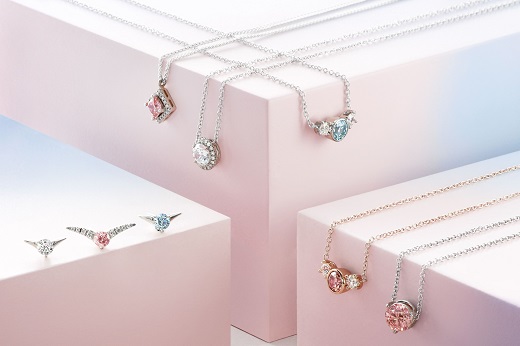|
|
De Beers’ Lightbox Chief Reveals 2019 Plans
With the synthetics brand now a reality, Lightbox managing director Steve Coe talks about what’s next for the project.
Dec 27, 2018 4:02 AM
By Joshua Freedman
|
|
|

RAPAPORT... De Beers shocked the industry in May by announcing it would launch
a line of fashion jewelry featuring laboratory-grown diamonds. Lightbox Jewelry
started selling the products online in September, and it’s now looking at
expansion options.
The main opportunity to develop the business will come once
the miner has finished building a $94 million synthetic-diamond facility in
Oregon in 2020. That center will grow about 500,000 carats of rough per year,
providing Lightbox with the bulk of its supply and complementing existing
production from its facility in Ascot, UK.
Partners in shine
The company is currently only selling the jewelry on its own
website, but plans to enter into partnerships with retailers for online and
in-store sales. 
A number of retailers have already expressed an interest in
stocking the product, according to Lightbox managing director Steve Coe, who
spoke with Rapaport Magazine earlier this year.
“We’ve started to have some very preliminary discussions
with a few, but as we’ve made clear from the start, our first step is going to
be to sell this product [through] e-commerce,” he says. “Our hope would be that
we could add a few retailers during 2019. To be honest, it’s going to be
somewhat limited in 2019, because it’s not until our new manufacturing plant in
Portland, Oregon, comes online in 2020 that we’re really going to have
substantial volumes that we could roll out to a wider retailer base.”
Lightbox will probably partner with fewer than 10 retailers
in the next year, though those companies will span many more individual stores,
he continues. In the long term, he
expects the jewelry to appear at retailers ranging from one-shop independents
to national chains.
Colorful future
Lightbox’s initial focus is the US market, as it has the
biggest consumer base. The brand could expand farther afield once supply has
increased post-2020, Coe points out.
It could also broaden the range of colors it offers, he
adds. Lightbox currently focuses on white, pink and blue synthetics up to 1
carat, and cites its own research showing that consumers consider lab-grown
diamonds a fun, everyday product rather than something they’d buy for big
milestones. That’s why it’s offering relatively low-cost, colorful fashion
jewelry at $800 per carat, rather than targeting the bridal market. Including
the setting, none of its products retail for more than $1,000.
“I would, on a two- to three-year time horizon, imagine us
expanding into certainly different shades of pink and blue,” Coe predicts. “We
can potentially go lighter or darker than the current colors, but also into
other colors. Yellow would be one very obvious opportunity, but also light
green [or] violet. There’s a number of colors that potentially we could do, and
[De Beers’ synthetics and industrial-diamond unit] Element Six’s scientists are
already starting to look into and consider that.”
Not all colors are equally creatable. Lightbox workers have
already shown they can produce various pink and blue hues, as well as violets
and light greens, Coe says. Red is harder to do, he notes, so Lightbox is
unlikely to offer it for the time being.
Lightbox’s initial offerings are earrings and necklaces with
simple, classic designs.
“The feedback we’ve had so far has all been very positive,”
Coe reports. “It’s clearly just a starting point. There’s lots of opportunity
to develop more interesting designs in the future.” The company is working with
its external designers on new looks featuring its current line of sizes and
colors, and those products are set to come on the market imminently, he adds.
More designs will appear in 2019.
(Since this interview, Lightbox has confirmed it would soon introduce bracelets and stackable rings.)
Natural diamonds still forever
Some traders fear De Beers’ entry into synthetics may damage
demand for lower-value categories of natural rough and polished diamonds.
However, Coe believes the commercial opportunities it brings are greater than
the perceived risk that consumers will buy lab-created diamonds instead of
similarly priced mined stones.
“We very much see Lightbox as an additive opportunity,” Coe
explains. “There’s a very strong colored element of the product range — pink
and blue stones — so that’s clearly something very different to natural
diamonds. [In addition,] we see this very much focused on more everyday gifting
occasions, self-purchase, teenage daughters. There’s very little overlap there
with traditional natural diamonds.”
Lightbox’s impact on the wider market will be minimal for
another simple reason: Its annual production is tiny compared with the
well-over-100 million carats of natural rough diamonds that come out of the
ground each year, he says.
Announcing it’s a rival
In marketing lab-grown diamonds as a fun, affordable
product, De Beers is taking a different approach from existing players in the
sector, who frequently sell synthetics as a lower-priced alternative for bridal
pieces. Lightbox’s strategy reflects what consumers have told De Beers
researchers, according to Coe: Diamonds from a machine look great, but they’re
not right for engagement rings.
“All we’re trying to do is put a product in the marketplace
that is what consumers are telling us they want,” he says. “That, to us, seems
to be a great route to try and maximize our chances of being commercially
successful. It’s up to other lab-grown-diamond suppliers what they do. My
personal view would be, I think they’re missing an opportunity not getting into
the fashion-jewelry space. But that’s not our concern.”
This article was first published in the December 2018
issue of Rapaport Magazine.
Images: Lightbox jewelry (above); Steve Coe (inset). (De Beers)
|
|
|
|
|
|
|
|
|
|
Tags:
Ascot, De Beers, element six, Joshua Freedman, lab-grown diamonds, laboratory-grown diamonds, Lightbox, Lightbox Jewelry, Oregon, Rapaport Magazine, retail, Steve Coe, Synthetics, technology, UK, US
|
|
|
|
|
|
|
|
|
|
|

|
|